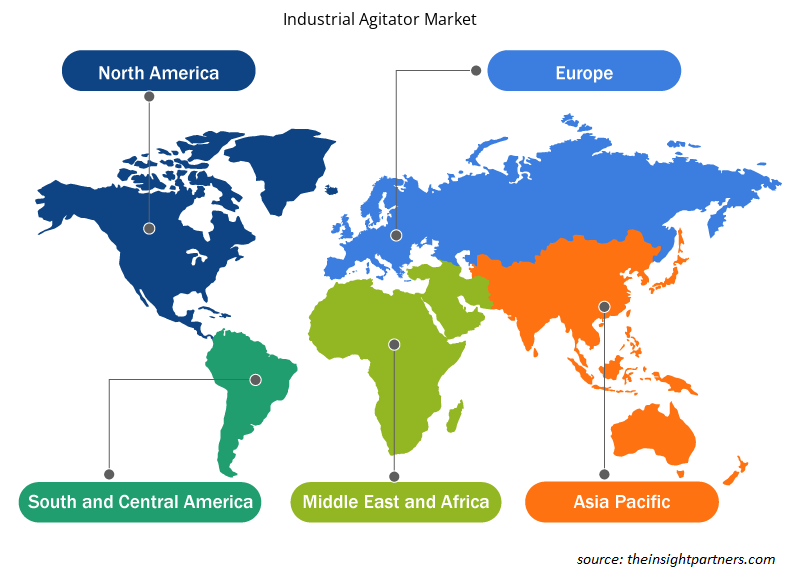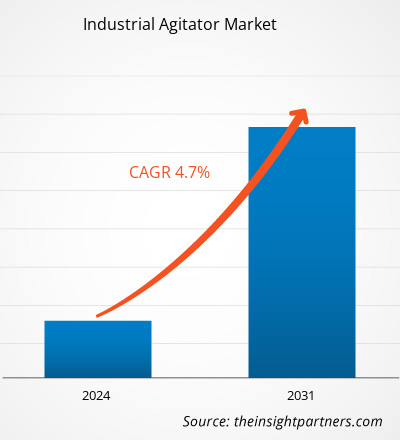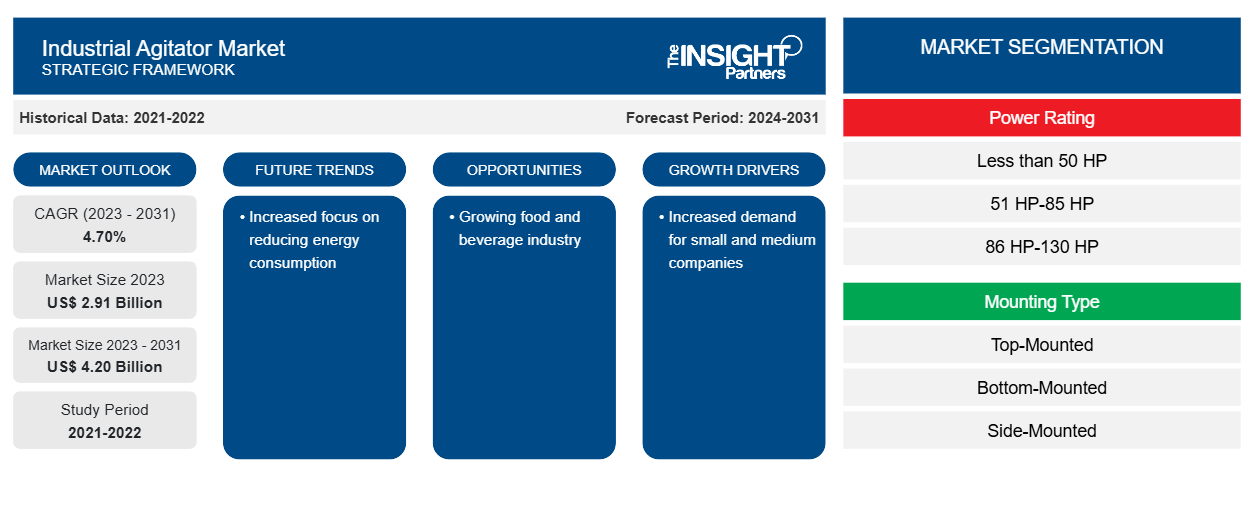La taille du marché des agitateurs industriels devrait atteindre 4,20 milliards USD d'ici 2031, contre 2,91 milliards USD en 2023. Le marché devrait enregistrer un TCAC de 4,70 % en 2023-2031. De nombreux fabricants du secteur se concentrent sur la réduction de la consommation d'énergie. Ainsi, la demande et l'adoption de composants économes en énergie tels que les variateurs de vitesse et la simulation numérique de la dynamique des fluides, entre autres, sont en hausse.
Analyse du marché des agitateurs industriels
Augmentation de la demande de l'industrie pharmaceutique. Les agitateurs de l' industrie pharmaceutique sont utilisés pour mélanger une large gamme de liquides et de poudres ainsi qu'une large gamme de matériaux. La croissance de l'industrie pharmaceutique augmente directement la demande d'agitateurs industriels. Par exemple, selon les données publiées par la Food and Drug Administration américaine en 2023, les installations biopharmaceutiques aux États-Unis en 2018 étaient au nombre de 1 018. Cependant, ce nombre a atteint 1 580 en 2023. De plus, selon les données publiées par la National Library of Medicine en 2022, les dépenses pharmaceutiques aux États-Unis ont augmenté d'environ 8 % en 2021 pour atteindre 576,9 milliards de dollars américains. Une telle croissance de l'industrie pharmaceutique stimule le marché.
Aperçu du marché des agitateurs industriels
De nombreux fabricants du secteur se concentrent sur la fourniture d'agitateurs personnalisés à leurs utilisateurs finaux. Les exigences de chaque utilisateur final sont différentes. Ainsi, les fabricants fournissent des solutions personnalisées. La catégorie des agitateurs industriels montés sur le dessus devrait dominer le marché. Les agitateurs montés sur le dessus garantissent un mélange homogène, une grande fiabilité du processus et de faibles coûts d'exploitation, entre autres. En outre, en termes de région, l'Asie-Pacifique devrait créer des opportunités lucratives pour le marché des agitateurs industriels en raison de la croissance continue du secteur industriel.
Personnalisez ce rapport en fonction de vos besoins
Vous bénéficierez d'une personnalisation gratuite de n'importe quel rapport, y compris de certaines parties de ce rapport, d'une analyse au niveau des pays, d'un pack de données Excel, ainsi que d'offres et de remises exceptionnelles pour les start-ups et les universités.
-
Obtenez les principales tendances clés du marché de ce rapport.Cet échantillon GRATUIT comprendra une analyse de données, allant des tendances du marché aux estimations et prévisions.
Facteurs moteurs et opportunités du marché des agitateurs industriels
Demande accrue pour les petites et moyennes entreprises
Le nombre total de petites et moyennes entreprises dans le monde augmente à l'échelle mondiale. Selon les données publiées par le gouvernement américain en 2023, il existe environ 33 millions de petites entreprises aux États-Unis, ce qui représente 46 % des entreprises du secteur privé aux États-Unis. Cela montre une augmentation du nombre de petites entreprises aux États-Unis. Un tel nombre croissant de petites entreprises stimule le besoin du marché des agitateurs industriels.
Croissance de l'industrie agroalimentaire et des boissons
La demande pour l'industrie alimentaire et des boissons augmente en raison de l'augmentation de la population. Selon les données publiées par les Nations Unies en 2023, la population mondiale devrait atteindre 8,5 milliards d'habitants d'ici 2030, tandis qu'en 2050, elle devrait atteindre 9,7 milliards. Une telle augmentation de la population devrait accroître la demande pour l'industrie alimentaire et des boissons, ce qui entraînera à terme la demande pour le marché des agitateurs industriels au cours de la période de prévision.
Analyse de segmentation du rapport sur le marché des agitateurs industriels
Les segments clés qui ont contribué à la dérivation de l’analyse du marché des agitateurs industriels sont le type, la cause, le type de trouble, la catégorie et les utilisateurs finaux
- En fonction de la puissance nominale, le marché des agitateurs industriels est divisé en moins de 50 ch, 51 ch-85 ch, 86 ch-130 ch et 131 et plus. Le segment 86 ch-130 ch détenait une part de marché plus importante en 2023.
- En fonction du type de montage, le marché est segmenté en montage supérieur, montage inférieur et montage latéral. Le segment monté sur le dessus détenait la plus grande part du marché en 2023.
- En termes de type de mélange, le marché est divisé en mélange solide-solide, mélange solide-liquide, mélange liquide-liquide et mélange liquide-gaz.
Analyse des parts de marché des agitateurs industriels par géographie
La portée géographique du rapport sur le marché des agitateurs industriels est principalement divisée en cinq régions : Amérique du Nord, Asie-Pacifique, Europe, Moyen-Orient et Afrique, et Amérique du Sud/Amérique du Sud et centrale.
L'Amérique du Nord a dominé le marché des agitateurs industriels. L'un des facteurs notables à l'origine de la croissance du marché des agitateurs industriels est la croissance accrue de l'industrie pharmaceutique. Selon les données disponibles dans le domaine public, les ventes de médicaments aux États-Unis ont totalisé environ 100 milliards de dollars américains, tandis que les ventes des mêmes médicaments ont totalisé 58 milliards de dollars américains en 2020. En outre, l'une des sociétés notables aux États-Unis, Johnson and Johnson, a enregistré un bénéfice de 17,9 milliards de dollars américains. En outre, Bristol Myers Squibb a généré un bénéfice de 6,7 milliards de dollars américains. Ces données montrent une industrie pharmaceutique américaine en augmentation et rentable. La croissance continue de l'industrie pharmaceutique a directement augmenté la demande pour le marché des agitateurs industriels au cours des dernières années.
Aperçu régional du marché des agitateurs industriels
Les tendances régionales et les facteurs influençant le marché des agitateurs industriels tout au long de la période de prévision ont été expliqués en détail par les analystes d’Insight Partners. Cette section traite également des segments et de la géographie du marché des agitateurs industriels en Amérique du Nord, en Europe, en Asie-Pacifique, au Moyen-Orient et en Afrique, ainsi qu’en Amérique du Sud et en Amérique centrale.

- Obtenez les données régionales spécifiques au marché des agitateurs industriels
Portée du rapport sur le marché des agitateurs industriels
| Attribut de rapport | Détails |
|---|---|
| Taille du marché en 2023 | 2,91 milliards de dollars américains |
| Taille du marché d'ici 2031 | 4,20 milliards de dollars américains |
| Taux de croissance annuel composé mondial (2023-2031) | 4,70% |
| Données historiques | 2021-2022 |
| Période de prévision | 2024-2031 |
| Segments couverts |
Par puissance nominale
|
| Régions et pays couverts |
Amérique du Nord
|
| Leaders du marché et profils d'entreprises clés |
|
Densité des acteurs du marché : comprendre son impact sur la dynamique des entreprises
Le marché des agitateurs industriels connaît une croissance rapide, tirée par la demande croissante des utilisateurs finaux en raison de facteurs tels que l'évolution des préférences des consommateurs, les avancées technologiques et une plus grande sensibilisation aux avantages du produit. À mesure que la demande augmente, les entreprises élargissent leurs offres, innovent pour répondre aux besoins des consommateurs et capitalisent sur les tendances émergentes, ce qui alimente davantage la croissance du marché.
La densité des acteurs du marché fait référence à la répartition des entreprises ou des sociétés opérant sur un marché ou un secteur particulier. Elle indique le nombre de concurrents (acteurs du marché) présents sur un marché donné par rapport à sa taille ou à sa valeur marchande totale.
Les principales entreprises opérant sur le marché des agitateurs industriels sont :
- Agitateurs Dynamix Inc.
- EKATO HOLDING GmbH
- Silverson
- Alfa Laval
- SPX FLOW, Inc.
- Sulzer Ltée
Avis de non-responsabilité : les sociétés répertoriées ci-dessus ne sont pas classées dans un ordre particulier.

- Obtenez un aperçu des principaux acteurs du marché des agitateurs industriels
Actualités et développements récents du marché des agitateurs industriels
Le marché des agitateurs industriels est évalué en collectant des données qualitatives et quantitatives après des recherches primaires et secondaires, qui comprennent d'importantes publications d'entreprise, des données d'association et des bases de données. Voici une liste des évolutions du marché des troubles de la parole et du langage et des stratégies :
- INOXPA a annoncé le lancement de la nouvelle gamme d'agitateurs latéraux DINAMIX SMX. Ce nouveau produit représente un changement important et stratégique au sein de la gamme d'agitateurs, favorisant et développant le concept modulaire. Il s'agit d'un système adaptable utilisant des composants standard pour produire de nombreuses configurations différentes, évitant ainsi la nécessité de fabriquer des agitateurs sur mesure. (Source : INOXPA, Communiqué de presse/Site Internet de l'entreprise/Newsletter, 2023)
- Sulzer a lancé le dernier ajout à la famille d'agitateurs SALOMIX, le SSF150. SALOMIX offre d'excellentes performances dans tous les segments industriels. La nouvelle taille sera principalement utilisée dans les grandes usines de pâte à papier, et les applications typiques seront les tours de stockage, les pulpeurs et les tours de blanchiment. Le SSF150 renforce la position de Sulzer en tant que premier fournisseur d'équipements complets pour l'industrie de la pâte, du papier et du carton. (Source : Nom de l'entreprise d'agitateurs industriels, communiqué de presse/site Web de l'entreprise/bulletin d'information, 2022)
Rapport sur le marché des agitateurs industriels : couverture et livrables
Le rapport « Taille et prévisions du marché des agitateurs industriels (2021-2031) » fournit une analyse détaillée du marché couvrant les domaines ci-dessous :
- Taille du marché et prévisions aux niveaux mondial, régional et national pour tous les segments de marché clés couverts par le périmètre
- Dynamique du marché, comme les facteurs moteurs, les contraintes et les opportunités clés
- Principales tendances futures
- Analyse détaillée des cinq forces de PEST/Porter et SWOT
- Analyse du marché mondial et régional couvrant les principales tendances du marché, les principaux acteurs, les réglementations et les développements récents du marché
- Analyse du paysage industriel et de la concurrence couvrant la concentration du marché, l'analyse de la carte thermique, les principaux acteurs et les développements récents
- Profils d'entreprise détaillés
- Analyse historique (2 ans), année de base, prévision (7 ans) avec TCAC
- Analyse PEST et SWOT
- Taille du marché Valeur / Volume - Mondial, Régional, Pays
- Industrie et paysage concurrentiel
- Ensemble de données Excel
Rapports récents
Témoignages
Raison d'acheter
- Prise de décision éclairée
- Compréhension de la dynamique du marché
- Analyse concurrentielle
- Connaissances clients
- Prévisions de marché
- Atténuation des risques
- Planification stratégique
- Justification des investissements
- Identification des marchés émergents
- Amélioration des stratégies marketing
- Amélioration de l'efficacité opérationnelle
- Alignement sur les tendances réglementaires























 Obtenez un échantillon gratuit pour - Marché des agitateurs industriels
Obtenez un échantillon gratuit pour - Marché des agitateurs industriels